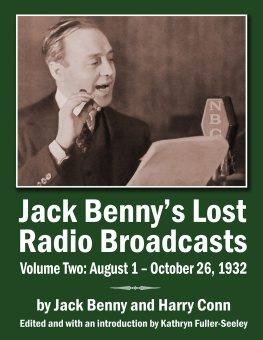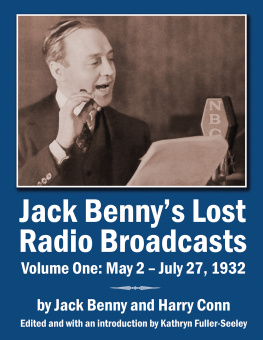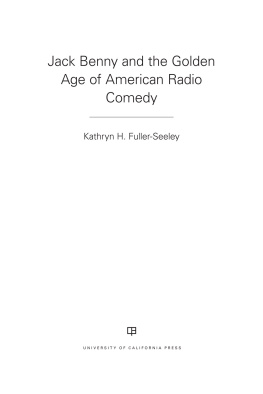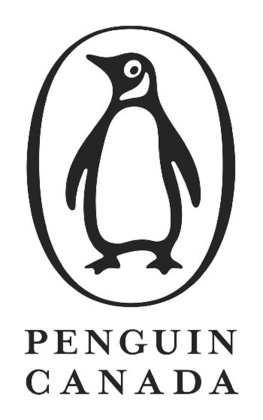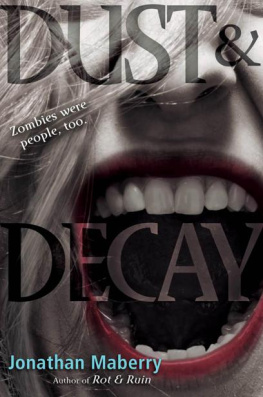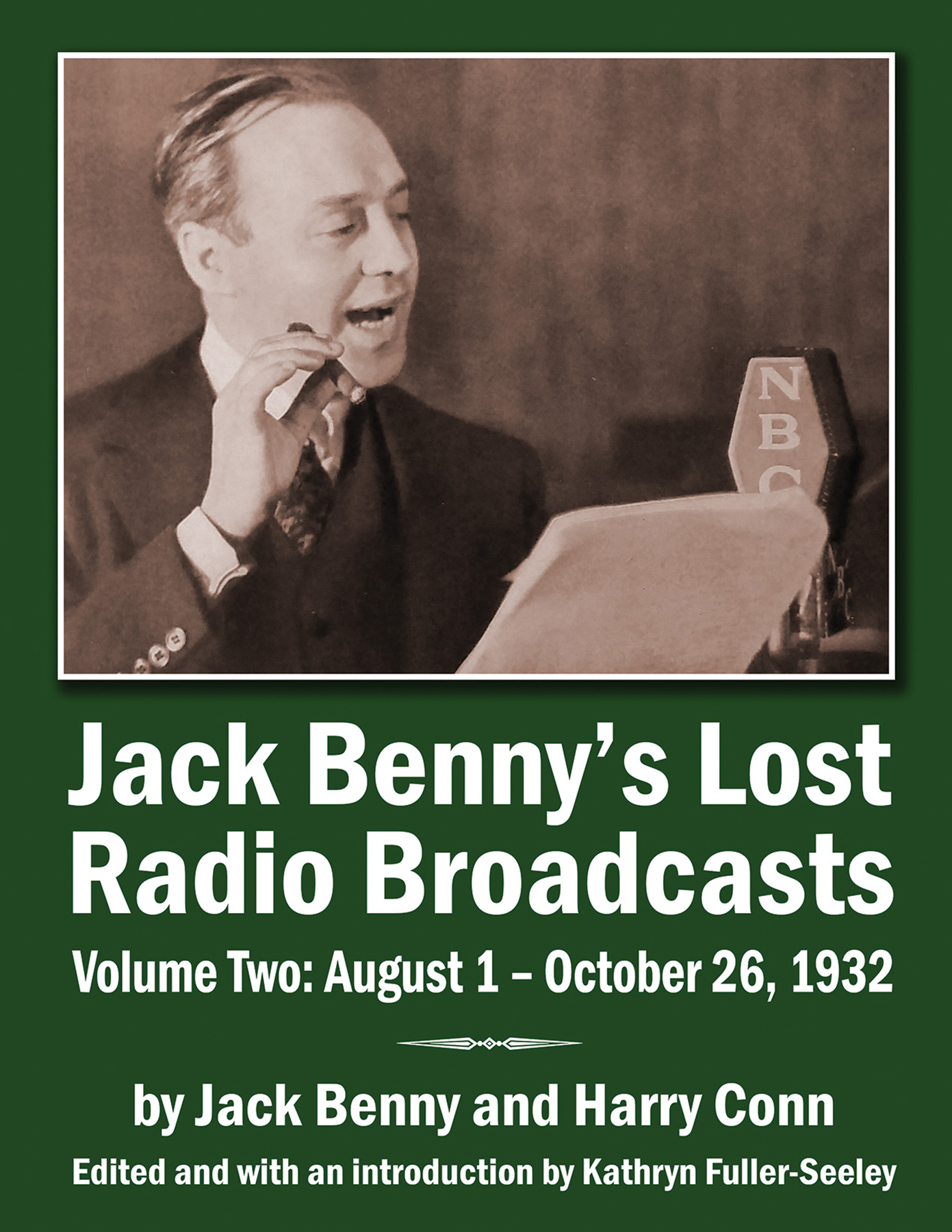Classic Cinema.
Timeless TV.
Retro Radio.
Introduction 2020 Kathryn Fuller-Seeley. All Rights Reserved.
No part of this book may be reproduced in any form or by any means, electronic, mechanical, digital, photocopying or recording, except for the inclusion in a review, without permission in writing from the publisher.
This version of the book may be slightly abridged from the print version.
Cover Design by John Teehan.
Introduction
In this second installment of Jack Bennys Canada Dry radio program, covering 26 episodes/ 13 weeks from August 1 through October 26, 1932, Mary Livingstone became a regular member of the shows cast, and the Olsen-Shutta-band-Jack-Mary-announcer group coalesced into a sharp-witted comedy troupe, under the tutelage of Jack Benny and Harry Conn. During these weeks of continued experimentation, Conn and Benny augmented their mix of lightly satirical commentary on early 1930s urban pop culture by creating several more explicitly political skits, less outrageous but still announcer-fueled obnoxious Canada Dry ads, the development of the Mary-Jack romance, and the first parodies of current Hollywood blockbusters and time-worn Victorian melodramas. The surprise twist at the end of this second volume is that Canada Dry decided to end the current set up and move Bennys comedy to a new network, with the comedy augmented by two additional writers (Sid Silvers and Dave Freedman) whom Benny, Conn and Livingstone did not want at all! I must APOLOGIZE that, in a pandemic-influenced oversight, I neglected to capture images from the September 26, 1932 episode of the Benny program. When we can travel to archives again, I will race to the UCLA archives and secure it for inclusion (I hope!) in Volume 3 of the Jack Bennys Lost Radio Broadcast collection. I also invite you to learn more about Bennys broadcasting career in my book Jack Benny and the Golden Age of American Radio Comedy (University of California Press, 2017) and through the excellent research, fellowship and fun created by members of the International Jack Benny Fan Club (www.jackbenny.org and on Facebook).
Brief Recap of Volume 1 of Jack Bennys Lost Radio Broadcasts (Canada Dry Program May 2-July 27, 1932)
The Canada Dry radio program, featuring Jack Benny, George Olsen and Ethel Shutta (pronounced shu- TAY), debuted on Monday May 2, 1932 at 9:30 pm Eastern time on the NBC Blue network. Broadcast twice a week (Mondays and Wednesdays) the program was produced in a small-glass-walled studio that NBC had erected in the former Roof Garden of the New Amsterdam Theatre in New York City. The new show was advertised as 30 minutes of music and quips featuring Olsens band and vocals by Ziegfeld Follies alumna Shutta. Their music would be interspersed with brief monologue segments performed by 38-year-old Jack Benny, a Midwestern-voiced, genially-self-deprecating vaudeville veteran known around New York as that sleekly bored joker and a Broadway Romeo.
The earliest episodes were heavy on monologues drawn from Bennys masters-of-ceremonies chatter, and were enlivened by some very droll commercials for the sponsors product. Quickly exhausting his library of vaudeville material, Benny soon hired vaudeville writer Harry Conn to provide fresh material for each show. The two worked out a concept for the Canada Dry program that melded Bennys well-practiced but seeming-easy repartee with other members of a vaudeville show cast on stage, with elements that seemed innovative to commercial radio in 1932. Jack joked with the announcer du jour and pulled him to the microphone to read lines and become a participant. Olsen and his musicians also became speaking cast members. The program began to resemble a sketchy version of a workplace situation comedy, with outrageously satirical commercials and product plugs scattered throughout the episode. The sponsor was appalled at the manhandling of the precious products reputation, but good reviews and piles of letters from delighted listeners convinced the shows advertising agency, N.W. Ayer & Sons, to let Benny and Conn continue.
Over the Canada Dry programs first thirteen weeks/ 26 episodes, the increasingly cohesive troupe moved away from the liveness of the studio microphone to go on make-believe journeys to a soda fountain, the zoo, and prize fights at Madison Square Gardens. Benny and Conn wrote skits that satirized sporting events, 4th of July fireworks, interview programs and the write-in-contests that then-currently plagued the airwaves.
Benny and Conn devised a mixture of comic monologues, repartee, pun tossing, and fictional adventures between the musical numbers, avoiding rigid formulas. Some of their experimental ideas were solidly successful, while some were problematic and abandoned as unworkable. Others ended perhaps at the behest of their sponsor. The outrageous Canada Dry middle commercials are a highlight of the earliest portion of Bennys radio career (see the Kentucky factory experiment on May 25 and the foot race between a talking glass of Canada Dry and a bottle of ketchup on May 30). Benny would continue to innovate new techniques of advertising humor with Jell-O and Lucky Strike cigarette commercials in the years to come.
In late June 1932, Jack began to talk about hiring an assistant to handle all the mail the program was receiving in response to the outrageous Canada Dry contests. In the final script of volume one, the July 27, 1932 script for the radio program, (last of the first 13 weeks), Jacks real wife Sadye Benny joined the program as a young woman named Mary Livingstone, a fan of the program from the small town of Plainfield, New Jersey. As you will see in our second volume, Mary assumed the role of Jacks lackadaisical part-time secretary on the radio show, and soon would become a central character.
Introduction to Volume 2 (Canada Dry program August 1-October 26, 1932)
These Canada Dry scripts from August through October 1932 show Jack Benny and scriptwriter Harry Conn continuing to craft a personality-based radio variety program, drawing on Bennys vaudeville style and exploring new constructions of comedy characters and situations. Experimenting as the program progressed from week to week, Benny and Conn developed quirky-yet-likeable identities for the major performers orchestra leader, vocalist, and band members, although the constantly changing announcer put a limit on how much they could involve him. The cast bounced jokes, reactions and bad puns off each other. The newest addition, young fan Mary Livingstone from Plainfield New Jersey, began to fit in with the established group.
Among the new and noteworthy elements we will find in this 13-week/ 26-episode chapter of the Jack Benny radio saga are:
Nickel Back on the Bottle becomes a nationally popular catch phrase
Marys first Labor Day poem is declaimed on September 5

